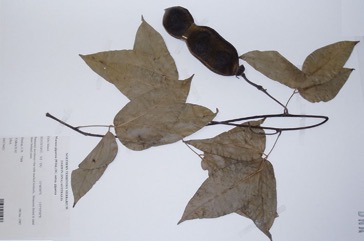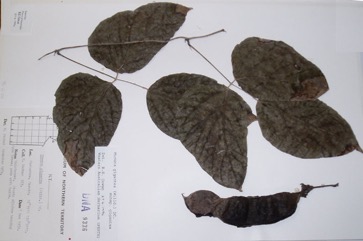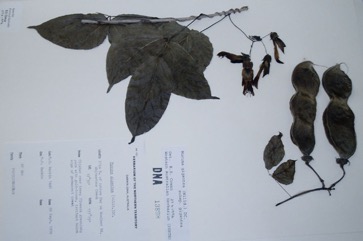Velvet bean, Burny Bean, Elephant cowitch, Sea bean

A tropical and subtropical plant. Plants grow naturally in monsoon vine forests. Often they are near the sea. They need well-drained soil. They can stand slight frosts. In Africa it grows up to 1,800 m altitude. It can grow in arid places.
Also known as:
Enugadulagondi, Kakavalli, Kalgaivalli, Macmeo khong-lo, Tupe, Turi-bilangi
Synonyms
- Dolichos gigantea Willd.
- Mucuna longipedicillata Haumann
- Mucuna quadrialata Baker
- Stizolobium giganteum Spreng.
Edible Portion
- Seeds, Pods
Where does Velvet bean grow?
Found in: Africa, American Samoa, Andamans, Asia, Australia, Central Africa, China, Congo, East Africa, Fiji, Hawaii, India, Indochina, Indonesia, Japan, Kenya, Kiribati, Lord Howe Island, Malaysia, Mozambique, Myanmar, Pacific, Papua New Guinea, PNG, Polynesia, Rotuma, SE Asia, Solomon Islands, South Africa, Tanzania, Tonga, Tuvalu, Uganda, United States, Vietnam
Notes: The hairs on the pods can irritate the skin. There are about 100 Mucuna species. They grow in tropical places.
Growing Velvet bean, Burny Bean, Elephant cowitch, Sea bean
Cultivation: Plants can be grown from seed. The seed need treatment to help them to grow. Seeds can float for long periods by water.
Edible Uses: The seeds can be eaten but must be cooked first.
Production: Plants grow very quickly. In Australia, plants flower from August to October and fruit in November to December.
Nutrition Info
per 100g edible portion| Edible Part | Energy (kcal) | Protein (g) | Iron (mg) | Vitamin A (ug) | Vitamin c (mg) | Zinc (mg) | % Water |
|---|---|---|---|---|---|---|---|
| - | - | - | - | - | - |
Velvet bean, Burny Bean, Elephant cowitch, Sea bean Photos



References
Ambasta, S.P. (Ed.), 2000, The Useful Plants of India. CSIR India. p 381
Bodkin, F., 1991, Encyclopedia Botanica. Cornstalk publishing, p 709
Brink, M., 2006. Mucuna gigantea (Willd.) DC. [Internet] Record from Protabase. Brink, M. & Belay, G. (Editors). PROTA (Plant Resources of Tropical Africa), Wageningen, Netherlands. < http://database.prota.org/search.htm>. Accessed 20 October 200919 October 2009.
Brock, J., 1993, Native Plants of Northern Australia, Reed. p 261 (Photo)
Burkill, I.H., 1966, A Dictionary of the Economic Products of the Malay Peninsula. Ministry of Agriculture and Cooperatives, Kuala Lumpur, Malaysia. Vol 2 (I-Z) p 1528
Cherikoff V. & Isaacs, J., The Bush Food Handbook. How to gather, grow, process and cook Australian Wild Foods. Ti Tree Press, Australia p 200
Cooper, W. and Cooper, W., 2004, Fruits of the Australian Tropical Rainforest. Nokomis Editions, Victoria, Australia. p 213
Cribb, A.B. & J.W., 1976, Wild Food in Australia, Fontana. p 95
Elliot, W.R., & Jones, D.L., 1993, Encyclopedia of Australian Plants suitable for cultivation. Vol 6. Lothian. p 450 (Photo)
Flora of Australia Volume 49, Oceanic Islands 1, Australian Government Publishing Service, Canberra. (1994) p 182
Flora of Solomon Islands
Franklin, J., Keppel, G., & Whistler, W., 2008, The vegetation and flora of Lakeba, Nayau and Aiwa Islands, Central Lau Group, Fiji. Micronesica 40(1/2): 169–225, 2008
Ghosh, A, 2014, Survey of Ethno-medicinal Climbing plants in Andaman and Nicobar Islands, India. Int. J. of Pharm. Life Sci. 5(7): July, 2014:3671-3677
Hedrick, U.P., 1919, (Ed.), Sturtevant's edible plants of the world. p 422
Hibbert, M., 2002, The Aussie Plant Finder 2002, Florilegium. p 199
Hinton, B & B., 1982, A Wilderness in Bloom. Wildflowers of tropical Australia. p 4
Jackes, B.R., 2001, Plants of the Tropics. Rainforest to Heath. An Identification Guide. James Cook University. p 55
Jones, D.L. & Gray, B., 1977, Australian Climbing Plants. Reed. p 126
Jones D, L, 1986, Ornamental Rainforest Plants in Australia, Reed Books, p 292
Lamoureux, C.H., 1976, Trailside Plants of Hawaii's National Parks. Hawaii Natural History Association. p 40
Low, T., 1992, Bush Tucker. Australia’s Wild Food Harvest. Angus & Robertson. p 98
Melzer, R. & Plumb, J., 2011, Plants of Capricornia. Belgamba, Rockhampton. p 372
Nicholson, N & H., 1996, Australian Rainforest Plants 3, Terania Rainforest Publishing. NSW. p 41
Paczkowska, G . & Chapman, A.R., 2000, The Western Australian Flora. A Descriptive Calatogue. Western Australian Herbarium. p 441
Peekel, P.G., 1984, (Translation E.E.Henty), Flora of the Bismarck Archipelago for Naturalists, Division of Botany, Lae, PNG. p 251, 248, 252
Pham-Hoang Ho, 1999, An Illustrated Flora of Vietnam. Nha Xuat Ban Tre. p 940
Prodr. 2:405. 1825
Royal Botanic Gardens, Kew (1999). Survey of Economic Plants for Arid and Semi-Arid Lands (SEPASAL) database. Published on the Internet; http://www.rbgkew.org.uk/ceb/sepasal/internet [Accessed 29th April 2011]
Scarth-Johnson, V., 2000, National Treasures. Flowering Plants of Cooktown and Northern Australia. Vera Scarth-Johnson Gallery Association. Cooktown, Australia. p 134
Singh, H.B., Arora R.K.,1978, Wild edible Plants of India. Indian Council of Agricultural Research, New Delhi. p 82
Smith, A.C., 1985, Flora Vitiensis Nova, Lawaii, Kuai, Hawaii, Volume 3 p 211
Thaman, R. R., 1987, Plants of Kiribati: A listing and analysis of vernacular names. Atoll Research Bulletin No. 296
Thaman, R. R, 2016, The flora of Tuvalu. Atoll Research Bulletin No. 611. Smithsonian Institute p 91
Townsend, K., 1994, Across the Top. Gardening with Australian Plants in the tropics. Society for Growing Australian Plants, Townsville Branch Inc. p 300
Verdcourt, B., 1979, Manual of New Guinea Legumes. Botany Bulletin No 11, Division of Botany, Lae, Papua New Guinea. p 443
Wheeler, J.R.(ed.), 1992, Flora of the Kimberley Region. CALM, Western Australian Herbarium, p 421
Yuncker, T.G., 1959, Plants of Tonga, Bernice P. Bishop Museum, Hawaii, Bulletin 220. p 146